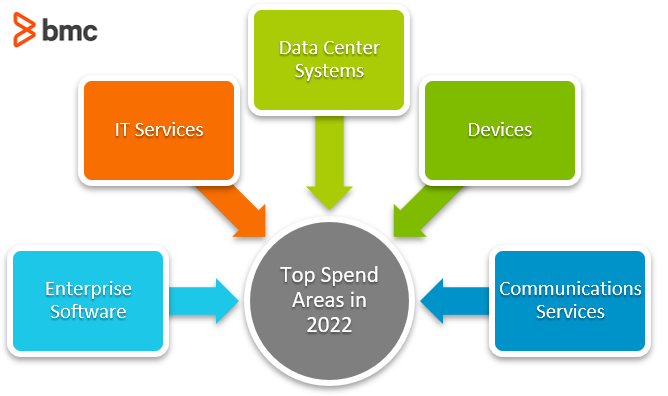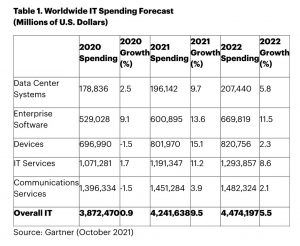Remote employees, supply chain headaches, openings, then closures, and the Great Resignation are just some of the stressful issues that most organizations and leaders have had to face this past year. And although many of the unknowns of the pandemic are hopefully coming to an end, that doesn’t mean uncertainty is out the door for 2022.
“Volatility is something that we clearly saw this year but it’s something that is going to be an ongoing theme,” said Monika Sinha, research vice president at Gartner, in a call ahead of the virtual Gartner IT Symposium/Xpo 2021.
“Volatility is something that is now a new normal.”
A majority of businesses were forced to adapt to the changes that the pandemic necessitated, and where some faltered, some also thrived. With new technologies and more digital work environments than ever, adaptation for the modern enterprise will continue to be critical.
“Our research this year showed that technology investments are going way up,” Sinha said. “In fact, technology investments are going to be at the highest they’ve been over the last decade.”
As organizations look towards 2022, the future seems encouraging, especially when it comes to IT spending. Let’s look at some of the top IT spending trends of 2022.
(This article is part of our IT Cost Management Guide. Use the right-hand menu to navigate.)

Worldwide IT spending
According to Gartner’s latest forecast, worldwide IT spending is projected to total $4.5 trillion in 2022, an increase of 5.5% from 2021, and the largest year-over-year jump in more than 10 years.
“Enterprises will increasingly build new technologies and software, rather than buy and implement them, leading to overall slower spending levels in 2022 compared to 2021,” said John-David Lovelock, distinguished research vice president at Gartner.
“However, digital tech initiatives remain a top strategic business priority for companies as they continue to reinvent the future of work, focusing spending on making their infrastructure bulletproof and accommodating increasingly complex hybrid work for employees going into 2022.”

(Source)
Fastest growing technology spending
As listed in the table above, Gartner’s IT spending forecast also notes the top five fastest growing technology market segments. In 2022, these include:
- Enterprise software
- IT services
- Data center systems
- Devices
- Communication services
Enterprise software
Overall, enterprise software is projected to have the highest growth rate in 2022, at 11.5%, going from an estimated $601 billion in 2021 to $670 billion in 2022. This increase in spending is largely driven by infrastructure software expenses outpacing application software spending.
IT services
IT services are quickly becoming one of the most critical assets for organizations to spend money on. Increasing 8.6% to $1.29 trillion in 2022, IT services are a high priority for many organizations as they are the key to digital transformation.
(Get the complete digital transformation guide.)
Data center systems
In 2022, Gartner predicts that spending on data center systems will hit $207 billion, representing a 5.8% year-over-year increase.
Connected to one of the biggest IT trends of 2022 is the multi-cloud and hybrid cloud environments, midsize businesses all the way to global enterprises will be mixing their on-premises options or data centers with a variety of cloud offerings, making the need for these systems to rise.
Devices
As remote learning, telehealth, and remote work took precedence, global spending on devices reached record levels in 2021 at over $800 billion. Although some of these might not be required in the months to come, Gartner still predicts there will be an increase in enterprise devices that need to be upgraded or invested in for hybrid work settings.
(Learn more about the IoT & the Internet of Behaviors.)
Communication services
Communication services will see the slowest overall growth rate for 2022 compared to 2021, but it still sits at the number one spot for the largest total spending levels next year at $1.48 trillion.
The pandemic challenged companies to get creative and operate outside normal comfort zones, and even the most opposed to remote workers suddenly faced entire teams going entirely digital. As a result, IT communications software and services will prove to continue to be vital in the year to come.
Long-term IT spending strategies
Although this spending increase is good news for the tech industry, CIOs will need to rethink what critical technology their organizations would be wise to invest in, not only creating a path for quick wins, but also being strategic with a long-term plan.
“What changed in 2020 and 2021 was not really the technology itself, but people’s willingness and eagerness to adopt it and use it in different ways,” said Lovelock. “In 2022, CIOs need to reconfigure how work is done by embracing business composability and the technologies that accommodate asynchronous workflows.”
As businesses continue to shift from legacy systems and upkeep towards technology investments that will advance the enterprise, it will also be crucial to increase cybersecurity spending, business intelligence, and cloud platform investments.
“Traditional work models do not provide the agility, scalability, and resilience required by the future enterprise,” said Holly Muscolino, research vice president of Content Strategies and the Future of Work at IDC.
“This was, of course, highlighted by the ongoing health crisis. To drive growth and competitive differentiation, organizations will invest in technologies and services that power automation, human-machine collaboration, new organizational structures and leadership styles, dynamic learning opportunities, a reimagined workplace, and a digital work environment that is not bounded by time or physical place.”
Future of Work
According to research from International Data Corporation (IDC), investments in various technologies that support Future of Work initiatives will exceed $1 trillion worldwide by 2024.
“All aspects of how people and organizations work are evolving, enabled by 3rd Platform technologies and accelerated by the pandemic,” said Karen Massey, research manager, Customer Insights & Analysis.
“Indeed 3rd Platform hardware, such as IoT devices, robots and drones, and IaaS, are more than one-third of the total spend, demonstrating the growing importance of the technologies enabling the reimagined workplace.”
Some use-cases that are projected to see the fastest spending growth rates in the next few years are:
- Interconnected collaborative workspaces
- Adaptive skill development
- Advanced project management
“Emerging technologies like artificial intelligence, the Internet of Things, and augmented/virtual reality are changing how work is getting done across all industries and across the world,” said Eileen Smith, program vice president, Customer Insights and Analysis.
“Seeking automated decision support and virtual collaborative approaches, discrete and process manufacturing, the two largest spenders on Future of Work technology over the forecast period, are investing in key use cases like collaborative robotics, operational performance management, and 3D and digital product design and review for improved cost control and higher process efficiency,”
BDA
IDC also predicts spending on big data and business analytics (BDA) solutions will reach $215.7 billion by the end of 2021, with a compound annual growth rate (CAGR) for global BDA spending over the 2021-2025 forecast to be 12.8%.
“As executives seek solutions to enable better, faster decisions, we’re seeing relatively healthy BDA spending across all industries. Leveraging data for insights into everything from internal business operations to the customer journey is top of mind and of strategic importance,” said Jessica Goepfert, program vice president, Customer Insights and Analysis.
As reported in the new Worldwide Big Data and Analytics Spending Guide, over half of all BDA spending in 2021 has gone to IT services, totaling $85 billion, with the second largest segment of BDA spending going towards software, seeing investments of over $82 billion.
IT spending trends
Large businesses are ready and willing to invest in their technologies this upcoming year, whether that be to update or replace legacy systems, or to continue to grow their IT projects. Overall, IT spending will see an increase compared to the past few years, with executives focusing on technologies that enhance and advance the digital work environment.
And after the past few years, this IT spending boom could never be so welcome.
Related reading
These postings are my own and do not necessarily represent BMC's position, strategies, or opinion.
See an error or have a suggestion? Please let us know by emailing blogs@bmc.com.






